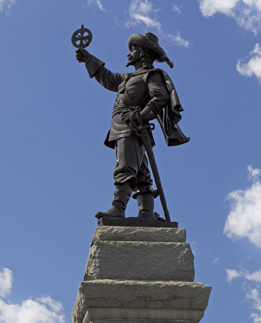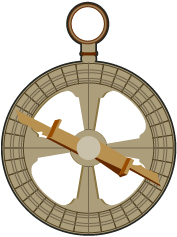Lesson 3
1. Lesson 3
Module 4: The Right Kind Of Triangles
Lesson 3: Trigonometry Review
Focus

National Capital Commission
At Nepean Point in Ottawa, there is a statue of Samuel de Champlain, the seventeenth-century French explorer, mapmaker, and “father of New France” (Québec). Champlain is shown holding an astrolabe. An astrolabe is an instrument used by mariners to determine location. An astrolabe is used to measure angles of elevation of the Sun or the North Star. From these measurements, and using mathematical tables based on trigonometry, the user could determine latitude or time. The astrolabe is an ancient form of GPS.
The mathematics of trigonometry is even more important to Canadian society today than it was four centuries ago. In this lesson you will review the basic concepts of right-triangle trigonometry. You explored these concepts in previous mathematics courses.
By the way, if you look carefully at de Champlain’s statue, you will notice he is holding the astrolabe upside down.

Lesson Questions
In this lesson you will investigate the following questions:
- How is right-triangle trigonometry applied in problem situations?
- What is the relationship between slope, angle of elevation, and the tangent ratio?
Assessment
Your assessment for this lesson may include a combination of the following:
- course folder submissions from the Try This and Share sections of the lesson
- your contribution to the Mathematics 20-3: Glossary Terms
- Lesson 3 Assignment (Save a copy of your lesson assignment to your course folder now.)
Materials and Equipment
- stiff paper or cardboard the size of printer paper
- scissors
- tape
- glue stick
- drinking straw
- a weight (such as a bolt or large washer)
- 30 cm of strong thread or fishing line
- tape measure (metric or imperial)
- calculator